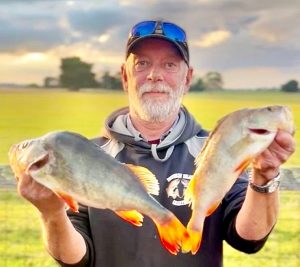
Four-year-old Eli McLoughlin shows he’s no slouch at catching whiting off Clifton Springs (Picture: Kevin McLoughlin).
Corio Bay/Bellarine Peninsula
Heading out off Clifton Springs on Saturday morning were Kevin McLoughlin, Marcus Pearson, and Kevin’s son Eli, who at the tender age of four, was no stranger to the gentle art of piscatorial assassination.
Whiting were their target species, of which they caught thirty altogether. This was despite the continual presence of two seven-gilled sharks cruising down below that could be clearly seen due to the extreme clarity of the water.
Fishing off the mouth of Swan Bay on the rising tide from mid-day on Saturday were Mark Sesar and Andrew Phillips who were also after whiting.
Initially anchored up near Coles Beacon, where there wasn’t much doing, they moved out to the east where the tide was so strong they had to use heavier sinkers.
But here, the whiting were well and truly on the bite, and from then on, they had no trouble taking their respective bag limits of fish to 44 cm.
Also, well and truly onto the whiting was Simon Werner who found a productive patch, from which he too took a limit catch of good size fish.

Ken Carman with another sample of the redfin he caught while of a lure testing session on Lake Purrumbete (Picture: Michael Evans).

Ken Carmans’s partner Mary with a 43 cm redfin taken during Ken’s lure-testing session (Picture Michae Evans).
Freshwater
Fishing contributor Frank Benvenuto’s most recent companion while fishing the Werribee River has been Ray Doolan from Geelong, who – given the snaggy nature of the river – has been fishing his bait under a float, a move that has yielded good results.
The main species sought here is Australian bass, which Frank has previously confided that, unlike in previous years, they have been difficult to tempt with lures. However, they may still be caught on bait; freshwater yabbies and scrubworms in particular.
Frank mentions that even on bait, the bite has slowed down with the onset of cold weather, and – more than likely – the breeders are heading downstream to spawn in the estuary. And, if history is any guide, those fish should be heading back upstream from September onwards.
Michael Evans of Victorian Inland Charters reports that his skipper Ken Carman, along with partner Mary, headed out onto Lake Purrumbete on Wednesday of last week testing Ken’s, yet to be released, soft plastics on this water’s abundant redfin.
As it turned out, they had a ripper two-hour session that produced over 60 Redfin with the biggest measuring 43cm, of which they kept 30 odd fish for the table.

(Clockwise from left) Billistic deckhand Gavin taking the photo by an extension, Murray Stewart holds onto wife Linda who holds onto her sailfish by the bill prior to release.
Upstate
Geelong fishing identities Murray and Linda Stewart. made the Journey to Broome in northwestern Australia where Murray caught up with the crew of “Billistic,” an 11.5 metre charter boat from which he’d fished some 17 years ago.
Booked in for Tuesday of last week, the weather gods were not smiling, nevertheless they headed north, sheltering along the coast in winds gusting offshore to 30 knots at times with Murray hoping for Linda to catch a sailfish.
Well, after travelling over 30 nautical miles to a reef renowned for sails, they put out the teasers. However, it was a long wait before a sail came in behind one of them, which was – in turn – substituted with a skilfully rigged garfish that did the job.
Well, that one – the only sail that they sighted – was released, but small tuna were plentiful, rounding out their catch for the day.

Lockie Wombell with a nice gummy shark, part of a catch made by him and Bob McPherson off Portland on Saturday (Picture: Bob McPherson).
Peter asks:
Geoff, I’ve been catching quite a few seven-gilled sharks of late, and we have enjoyed dining on them. My question is: Are the bigger ones a risk because of their supposed high mercury levels?
Peter, the good news is that most fish in Australian waters have very low mercury levels.
In sharks, larger sharks in particular, the level is elevated but not usually high enough to cause health problems. However, authorities warn women planning pregnancy, pregnant women, breastfeeding women and children under six, not to eat shark because of elevated mercury levels.
However, all high-end predators like tuna, marlin, swordfish etc, all have similarly elevated levels of organic mercury.
Please send your reports to occytrapper@gmail.com or by phone to 03 5248 1307.
